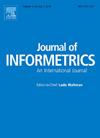从知识层次结构角度预测科学知识的角色转换
IF 3.4
2区 管理学
Q2 COMPUTER SCIENCE, INTERDISCIPLINARY APPLICATIONS
引用次数: 0
摘要
科学知识的演变有几种潜在的模式。为了深入探讨知识演化过程中功能和角色的变化,我们提出了一个研究框架,从层次结构的角度考察科学知识角色的转换。我们构建了过渡可能性和过渡类型两个分类模型,以预测是否发生角色过渡以及属于哪种类型的角色过渡。我们利用 PubMed 中的全部出版物语料库和 MeSH 的历史记录构建了多个数据集。在过渡类型预测和过渡可能性预测任务中,梯度提升分类器的表现最好。过渡可能性二元分类模型的精确度为 72.58 %,召回率为 71.04 %,F1 得分为 71.78 %。过渡可能性多分类模型的宏观 F1 得分为 61.29 %,微观 F1 得分为 84.07 %,加权 F1 得分为 82.90 %。此外,我们发现知识谱系特征对过渡可能性预测的贡献最大,而知识属性和网络结构特征对过渡类型预测的影响明显更大。大多数特征对 "内容变化 "类型的角色转换有明显影响,其次是 "子代 "和 "本地化转移 "类型。本文章由计算机程序翻译,如有差异,请以英文原文为准。
Scientific knowledge role transition prediction from a knowledge hierarchical structure perspective
There are several potential patterns in the evolution of scientific knowledge. In order to delve deeper into the changes in function and role during the evolution of knowledge, we have proposed a research framework that examines the transition of scientific knowledge roles from the perspective of a hierarchical structure. We constructed two classification models of transition possibility and transition type to predict whether one undergoes a role transition and which type of role transition it belongs to. Several datasets were constructed by utilizing the entire corpus of publications available in PubMed and the history records of MeSH. Among the tasks of transition type prediction and transition possibility prediction, the Gradient Boosting classifier performed the best. The binary classification model of transition possibility achieved a precision of 72.58 %, a recall of 71.04 %, and an F1 score of 71.78 %. The multi-classification model of transition possibility had a macro-F1 score of 61.29 %, a micro-F1 score of 84.07 %, and a weighted-F1 score of 82.90 %. Further, we found that the knowledge genealogy features contribute the most to the prediction of transition possibility while knowledge attribute and network structure features have a significantly greater influence on the prediction of transition type. Most features have an obvious effect on the role transition of the Content-change type, followed by Child-generation and Localization-shift types.
求助全文
通过发布文献求助,成功后即可免费获取论文全文。
去求助
来源期刊

Journal of Informetrics
Social Sciences-Library and Information Sciences
CiteScore
6.40
自引率
16.20%
发文量
95
期刊介绍:
Journal of Informetrics (JOI) publishes rigorous high-quality research on quantitative aspects of information science. The main focus of the journal is on topics in bibliometrics, scientometrics, webometrics, patentometrics, altmetrics and research evaluation. Contributions studying informetric problems using methods from other quantitative fields, such as mathematics, statistics, computer science, economics and econometrics, and network science, are especially encouraged. JOI publishes both theoretical and empirical work. In general, case studies, for instance a bibliometric analysis focusing on a specific research field or a specific country, are not considered suitable for publication in JOI, unless they contain innovative methodological elements.
 求助内容:
求助内容: 应助结果提醒方式:
应助结果提醒方式:


